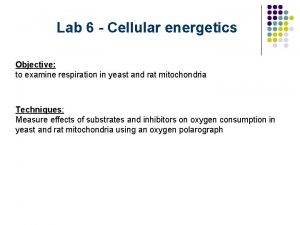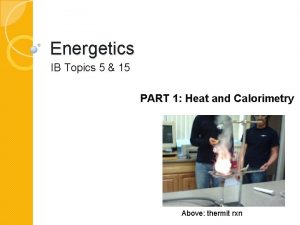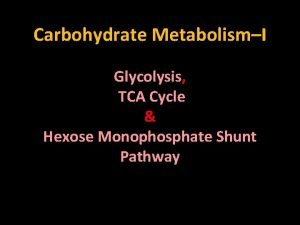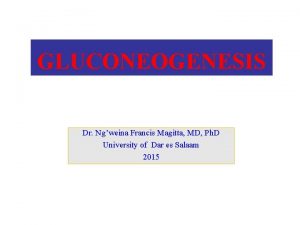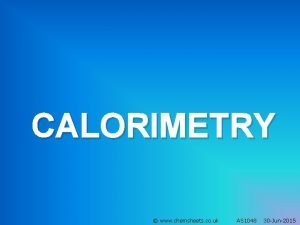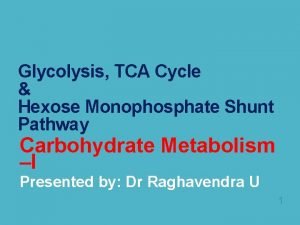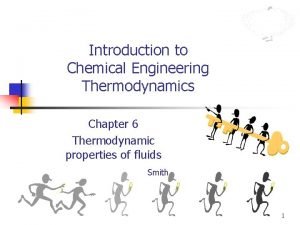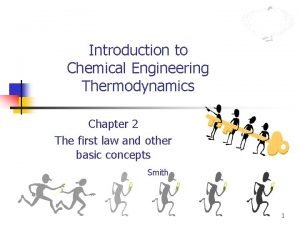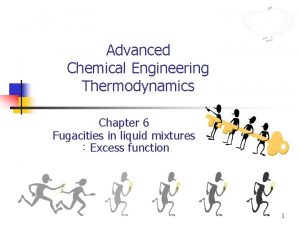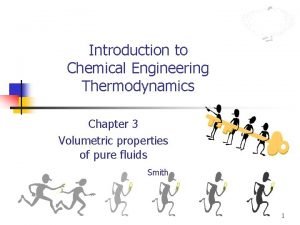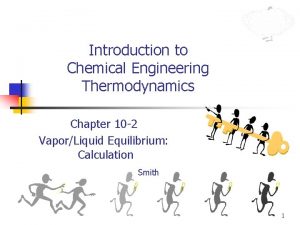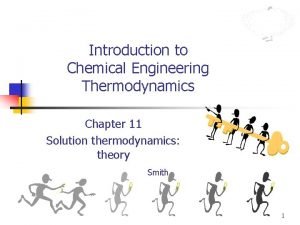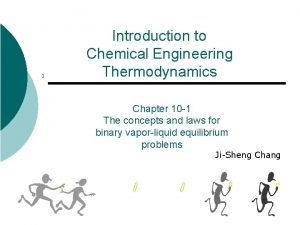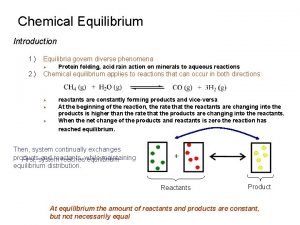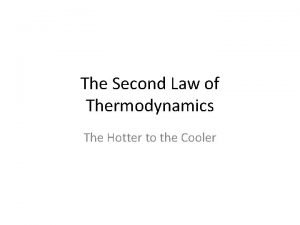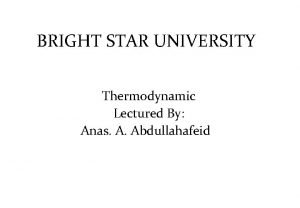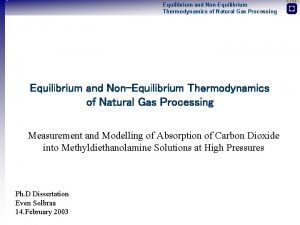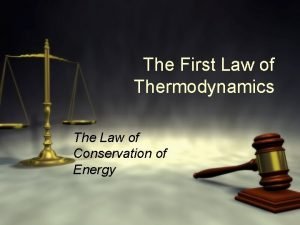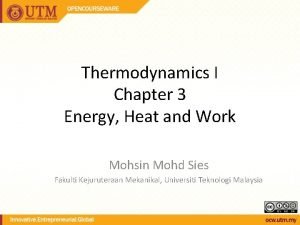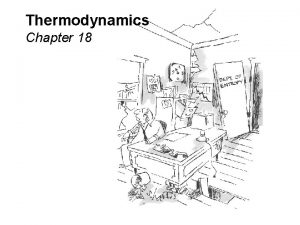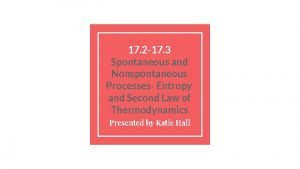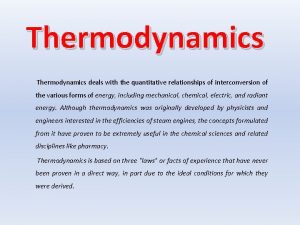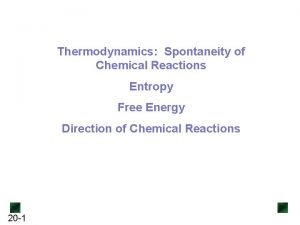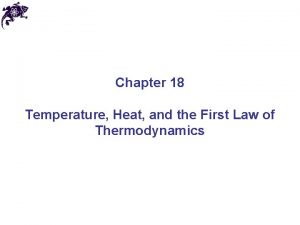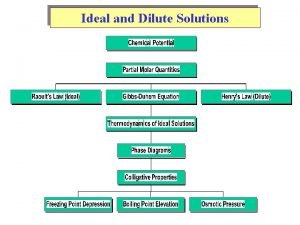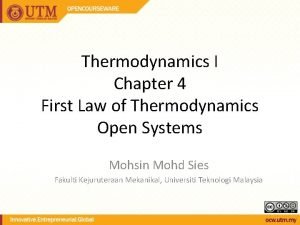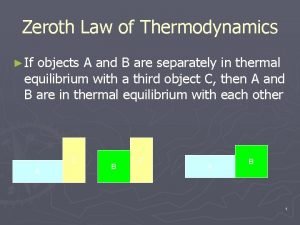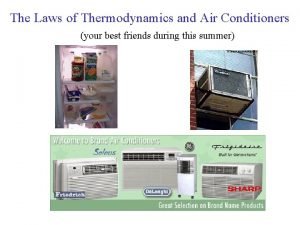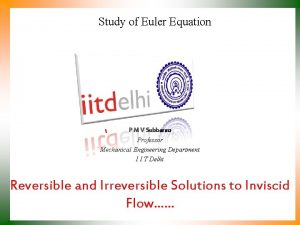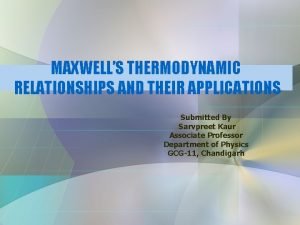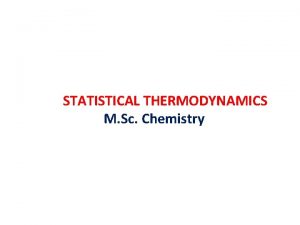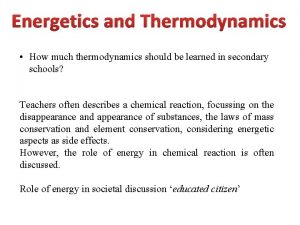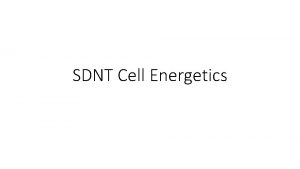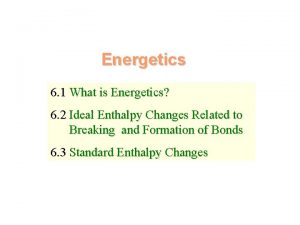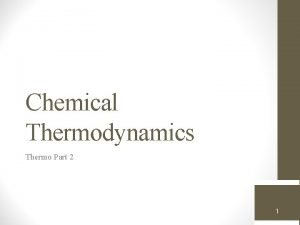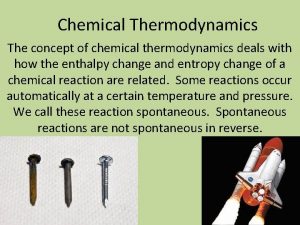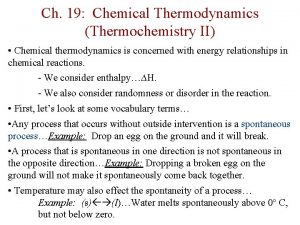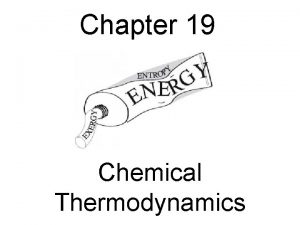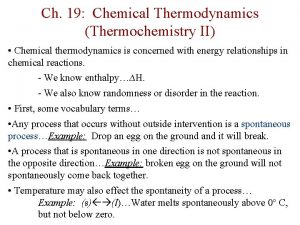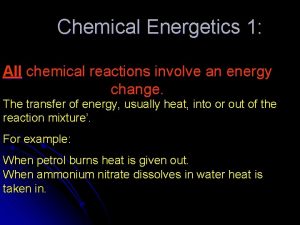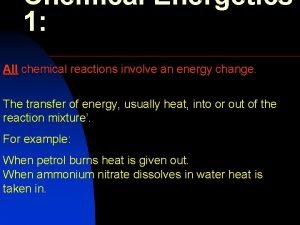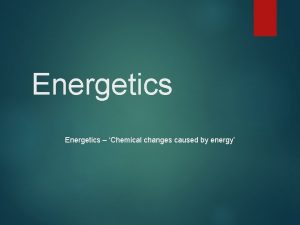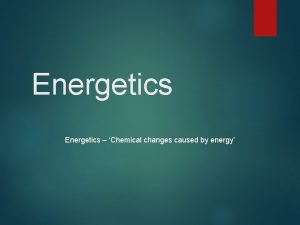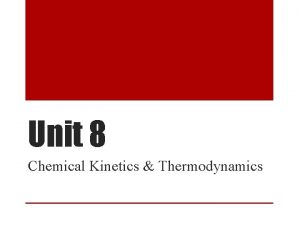Chemical Thermodynamics Energetics Sontakke S A Chemical Thermodynamics














































- Slides: 46

Chemical Thermodynamics & Energetics Sontakke S. A.

Chemical Thermodynamics & Energetics First law of thermodynamics & its limitations

Statements • Energy can neither be created nor be destroyed. • One form of energy disappears exactly equivalent amount of some other form of energy reappears. • Total energy of universe is constant. • Total energy of an isolated system is constant. • It is merely the law of conservation of energy

Limitations • Limitations of the first law of thermodynamics are discussed below: • 1. No restriction on the direction of the flow of heat: the first law establishes definite relationship between the heat absorbed and the work performed by a system. The first law does not indicate whether heat can flow from a cold end to a hot end or not. For example: we cannot extract heat from the ice or cold water by cooling it to a low temperature and use it to make the tea hot. • This is possible by first law of thermodynamics • .

• 2. Does not specify the. feasibility of the reaction: first law does not specify that process is feasible or not for example: when a rod is heated at one end then equilibrium has to be obtained which is possible only by some expenditure of energy. • 3. Practically it is not possible to convert the heat energy into an equivalent amount of work. • To overcome this limitations, another law is needed which is known as second law of thermodynamics

Second law of thermodynamics • The spontaneous flow of heat is always unidirectional, from higher temperature to lower temperature. • Heat can not be converted into exactly equivalent amount of work without producing permanent changes either in system or surrounding. • No machine yet to have unit efficiency.

Spontaneous and nonspontaneous process • Definition: -It is the process that takes place of its own without the external influence.

Some examples are • 1. Flow of water from higher level to lower level. • 2. Flow of heat from hot end to cold end. 3. Neutralization of acid by base. 4. Flow of gas from high pressure to low pressure.

Spontaneous Processes • The gas in vessel B will spontaneously effuse into vessel A, but once the gas is in both vessels, it will not spontaneously

Characteristics of spontaneous process • All spontaneous processes have a tendency to take place in particular direction on their own. • Spontaneous process may be fast or slow • Some spontaneous reaction may needs initiation.

All spontaneous processes proceed until a state of equilibrium is attained.

Processes that are spontaneous in one direction are nonspontane ous in the reverse direction.

Spontaneous Processes that are spontaneous at one temperature may be nonspontaneous at other temperatures. Above 0 C it is spontaneous for ice to melt. Below 0 C the reverse process is spontaneous.

Driving force that makes the process spontaneous 1. Energy and spontaneity • All spontaneous process are exothermic, that it tend to have lowest potential energy and maximum stability.

Examples • 1) combustion of 1 mol of carbon ΔH = -394 k. J/mol • Formation of two mol of ammonia from nitrogen and hydrogen ΔH = 92. 4 k. J • Formation of 1 mol of water from hydrogen and oxygen Δ H =-285. 7 k. J/mol

Limitation to criterion of decrease in enthalpy 1) Some endothermic reactions are also known to occur spontaneously. Such as • Evaporation of water from open container or sea water ΔH =+44. 0 k. J • Dissolution of NH 4 Cl in water ΔH=+15. 1 k. J

• Reaction do not goes to completion even ΔH value is negative • Reversible reaction also occurs. Forward reaction is exothermic while backward reaction is endothermic

2. Randomness or disorder & Spontaneity • The process proceeds spontaneously in a direction in which the randomness or disorder of system increases. Dissolution of solid:

Entropy Is this your room/ Then you already know about entropy

Definition : - It is measure of molecular disorder or randomness.

• Gases have higher entropies than liquids. • Liquids have higher entropies than solids. • Entropy is greater for larger atoms. • Entropy is greater for molecules with more atoms. In general Ssolid Sliquid Sgas


Examples • Ar has higher entropy than Ne as Ar molecules are larger. • C 8 H 18(l) has higher entropy than C 5 H 12(l) as complex molecules have higher entropy than simple ones. • Br 2(g) has higher entropy than Br 2(l) as gases have higher entropies than liquids since gases have more ways of being arranged

By this criteria for any spontaneous process the entropy of system increases i. e ΔSsystem value is +ve • • E. g Iodine dissolve in water ΔS= +ve Hydrogen molecule into hydrogen atom ΔS= +ve Evaporation of water ΔS= +ve Ammonium chloride dissolved into water ΔS= +ve

Quantitative definition of entropy • Instead of absolute entropy(S), entropy change(ΔS) is measured.

Entropy change of system in a process is amount of heat absorbed isothermally and reversibly divided by absolute temperature • Mathematically it is expressed as Unit of entropy change Since q is expressed in joule and temperature in kelvin ΔS is expressed in J /K

Entropy and second law of thermodynamics • Entropy of system increases in spontaneous process • However only entropy of system is not sufficient to talk about the spontaneity of process. • Though ΔS value –ve , reaction is spontaneous, thus total entropy i. e system and surrounding is considered.

• - The entropy of the universe always increases in a spontaneous process and remains unchanged in an equilibrium process • ΔS> 0 “But ma, it’s not my fault… the universe wants my room like this!”>

Statement: -Total entropy of system and its surrounding(universe) increases in the spontaneous process. Entropy Change in the Universe • The universe is composed of the system and the surroundings. Therefore, Suniverse = Ssystem + Ssurroundings • For spontaneous processes Suniverse > 0

Figure 20. 10 Components of S 0 universe for spontaneous reactions Suniverse = Ssystem + Ssurroundings system becomes more disordered system becomes more ordered

If entropy always increases, how can we account for the fact that water spontaneously freezes when placed in the freezer? • • Movement of compressor • + • • Evaporation and condensation of refrigerant • + • • Warming of air around container • Net increase in the entropy of the universe

Gibbs energy and Gibbs energy change & spontaneity. • Most of chemical reaction takes place either in closed system or open system, there is change of enthalpy as well as entropy takes place. It is not possible to achieve both factor [minimum energy and maximum stability] simultaneously , so new thermodynamic function is introduced called as Gibbs energy(G)

Definition: -It is the maximum amount of energy available to a system during a process that can be converted into useful work. • Mathematical expression. G = H -TS • Gibbs energy change is ΔG =ΔH -TΔS

Gibbs energy change: - = – Gibbs Free Energy

= – Gibbs Free Energy Make this equation nicer:

Practical uses: surroundings & system …Gibbs Free Energy T Suniverse is defined as the Gibbs free energy, G. For spontaneous processes: Suniverse > 0 And therefore: G < 0 G is easier to determine than Suniverse. So: Use G to decide if a process is spontaneous.

G as a criteria for spontaneity. 1. If G is negative, the forward reaction is spontaneous. 2. If G is 0, the system is at equilibrium. 3. If G is positive, the reaction is spontaneous in the reverse direction.

Free Energy and Temperature

Temperature of equilibrium • At equilibrium process is neither spontaneous nor nonspontaneous. So at equilbrium ΔG = 0, therefore the equation ΔG = ΔH –TΔS Can be written as 0 = ΔH –TΔS T= ΔH /ΔS

Gibbs energy change & equilibrium constant Q is the reaction quotiant Note: at equilibrium: G = 0. and Q =K sign of G tells which way reaction goes spontaneously.


Third law of thermodynamics • Entropy of a perfectly ordered crystalline substance is zero at absolute zero temperature. 0 K Importance of this law is to determine absolute entropy of any substance. When substance at T=0 with S=0 is heated from 0 K to T K, the increase in entropy ΔS = ST - So= At T=0, S=0, thus

Calculating the Entropy Change Sorxn = n So(products) - m So(reactants)

Sample Problem 20. 1: PROBLEM: Predicting Relative Entropy Values Choose the member with the higher entropy in each of the following pairs, and justify your choice [assume constant temperature, except in part (e)]: (a) 1 mol of SO 2(g) or 1 mol of SO 3(g) (b) 1 mol of CO 2(s) or 1 mol of CO 2(g) (c) 3 mol of oxygen gas (O 2) or 2 mol of ozone gas (O 3) (d) 1 mol of KBr(s) or 1 mol of KBr(aq) (e) Seawater in midwinter at 20 C or in midsummer at 230 C (f) 1 mol of CF 4(g) or 1 mol of CCl 4(g)

In general less ordered systems have higher entropy than ordered systems and entropy increases with an increase in temperature. PLAN: SOLUTION: (a) 1 mol of SO 3(g) - more atoms (d) 1 mol of KBr(aq) - solution > solid (b) 1 mol of CO 2(g) - gas > solid (e) 230 C - higher temperature (c) 3 mol of O 2(g) - larger #mols (f) CCl 4 - larger mass

Thank you & Bye
 Sodium azide electron transport chain
Sodium azide electron transport chain Ib energetics
Ib energetics Anaplerosis
Anaplerosis Energetics power tower 180
Energetics power tower 180 Energetics janesville
Energetics janesville Glycolysis energetics
Glycolysis energetics Gluconeogenesis from lactate
Gluconeogenesis from lactate Calorimetry 2 chemsheets answers
Calorimetry 2 chemsheets answers Hmp shunt definition
Hmp shunt definition Building energetics
Building energetics Chapter 6
Chapter 6 Chemical engineering thermodynamics 8th solution chapter 2
Chemical engineering thermodynamics 8th solution chapter 2 Chemical engineering thermodynamics 8th solution chapter 6
Chemical engineering thermodynamics 8th solution chapter 6 Chemical engineering thermodynamics 8th solution chapter 3
Chemical engineering thermodynamics 8th solution chapter 3 Chemical engineering thermodynamics 8th solution chapter 10
Chemical engineering thermodynamics 8th solution chapter 10 Chemical engineering thermodynamics 8th solution chapter 4
Chemical engineering thermodynamics 8th solution chapter 4 Chemical engineering thermodynamics 8th solution chapter 10
Chemical engineering thermodynamics 8th solution chapter 10 Thermodynamics chemical equilibrium
Thermodynamics chemical equilibrium Chapter 7 review modern chemistry answers
Chapter 7 review modern chemistry answers Chapter 7 review chemical formulas and chemical compounds
Chapter 7 review chemical formulas and chemical compounds Chapter 18 chemical reactions balancing chemical equations
Chapter 18 chemical reactions balancing chemical equations Section 2 classifying chemical reactions
Section 2 classifying chemical reactions Chemical reactions section 1 chemical changes
Chemical reactions section 1 chemical changes Section 2 classifying chemical reactions
Section 2 classifying chemical reactions 11th chemistry thermodynamics lec 10
11th chemistry thermodynamics lec 10 Second law of thermodynamics
Second law of thermodynamics Reversible and irreversible processes in thermodynamics
Reversible and irreversible processes in thermodynamics Thermodynamics
Thermodynamics Isobaric process formula
Isobaric process formula Thermodynamics chapter 3
Thermodynamics chapter 3 Thermodynamics
Thermodynamics Are nonspontaneous processes impossible
Are nonspontaneous processes impossible Thermodynamics deals with
Thermodynamics deals with Spontaneous reaction
Spontaneous reaction 11th chemistry thermodynamics lec 13
11th chemistry thermodynamics lec 13 1st law of thermodynamics
1st law of thermodynamics Thermodynamics equations
Thermodynamics equations Sssf thermodynamics
Sssf thermodynamics Zeroth law of thermodynamics
Zeroth law of thermodynamics Steady flow process thermodynamics
Steady flow process thermodynamics Air conditioner thermodynamics
Air conditioner thermodynamics Euler equation thermodynamics
Euler equation thermodynamics Deriving maxwell relations
Deriving maxwell relations Statistical thermodynamics is a study of
Statistical thermodynamics is a study of Ideal solution thermodynamics
Ideal solution thermodynamics Thermodynamics
Thermodynamics Isentropic compressor
Isentropic compressor
